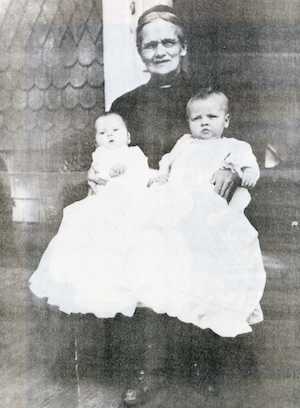Patterson Family History
-
October 27, 1851
James Gould Patterson, Jr. Was Born.

James Gould Patterson, Jr. was born October 27, 1851 in Horry County, South Carolina, to James Sr. and Martha Marlow Patterson. He had twelve siblings and was of Scottish descent. Although his two oldest brothers fought for the Confederacy and one of them died, the family did not own slaves. The business that would most affect Patterson’s life and what would eventually attract him to Thomasville, turpentining, is believed to have been passed to him from his father.
-
Mid-1870s
James Jr. moved to Whiteville, North Carolina.
By the mid-1870s, James Jr. moved to Whiteville, North Carolina where he met his future wife, Mary Smith, a young widow of a Presbyterian preacher. Although James already had experience in “naval stores,” the archaic phrase for extracting turpentine from pine trees, he opened a general store in Whiteville and operated it for several years. He and Mary, who had married in 1879, moved to Loris, South Carolina where James Sr. was operating a turpentine still. Rather than enter into business with his father, James opened a store in Loris’s newly built downtown and opened a still with partner A.F. Toon. He remained connected to Loris through 1894, acting as the town’s postmaster for a seven-year period. The Patterson family cemetery in the small South Carolina town became the city’s public burial grounds.
-
1980 - 1896
Meanwhile, James’ brother Angus had been operating a turpentine still in Telfair County, Georgia, since the early 1880s. In 1896, James purchased Angus’ still; two years later, all four living Patterson brothers were turpentining in Telfair County. They were not working with each other or in the same part of the county, and in James’ case, his family was not with him.
-
1900 - 1905
Mary and their now complete family, eight children total.
Mary and their now complete family, eight children total, were mostly living in Whiteville in 1900, with the exception of the two oldest sons who were working with their father in Telfair County. That year, James sold his Telfair still and purchased his first in Thomas County, where his brother Ashley had purchased a still several years earlier. By 1905, James wanted the entire family to move to Thomas County, preferably near Ochlocknee where the Patterson Still was.
-
Summer of 1905
Mary would not move to Ochlocknee, so James Patterson purchased the big yellow house.
Mary would not move to Ochlocknee, so James Patterson purchased the big yellow house on Dawson Street in the summer of 1905, and the family moved in a few months later. How it is the Laphams and Larmons utilized the different rooms of the house are largely speculative, based on the third-person, decades removed stories for the Laphams, and no one for the Larmons – but the Patterson’s use of the different rooms of the house is well documented.
The dining room in the center of the house, as one might expect, was used for family meals. In addition, it was the reception room for celebrations, including the weddings of two of James Patterson’s daughters. To the right of the dining room is the men’s parlor, or for the Patterson’s use, the formal living room. This room contained the Patterson’s nicest furniture and was used for formal events. The children, including the grown ones, were not expected to use this room on a regular basis. To the left of the dining room is the woman’s parlor, which the Pattersons called the “library” or simply “living room.” This was the room the Patterson children could play in.
From the men’s parlor/formal living room down the south wing was James’ and Mary’s bedroom. The small hallway/closet/nursery that connected to the back room was used as a dressing room, which during the time of the Patterson’s residency had an entrance to the bathroom. The back room of the south wing was first used as the bedroom of the younger sons, Tom and Bruce. After the children moved out and James Patterson suffered a stroke, it was used as Mary Patterson’s bedroom.
The north wing exits from the rear of the dining room into a small butler’s pantry, which enters the kitchen. Behind the kitchen is a room that James Patterson used as his business office, and built a large organizer along one of the walls with mail slots and storage cabinets. The two small rooms behind the kitchen were originally a wood storage room and the laundry room, which Patterson eventually converted into a single, large screened-in porch. The two rooms were restored to their original form when the State of Georgia restored the Lapham-Patterson House in the early 1970s.
The unusual second floor was used by the Pattersons for bedrooms. On the Webster Street side, with only an entrance from a small outdoor balcony is a bedroom that was called “Dolla’s Room” by the Pattersons, because her name was carved into a wall bracket – Dolla being the eldest Lapham child who died of illness while in Thomasville. Since the room did not have a fireplace and only one window, the Pattersons used this as a storage room.
-
1970s
Also on the Webster Street side, but with multiple windows, a fireplace, and multiple exits are one of the two large traditional bedrooms on the second floor. James Lloyd Patterson, the oldest son, lived in there from the time the Pattersons moved in, through the first year of his marriage in 1913. The uses of the other large bedroom, as well as the open, matching sitting rooms that occupy the center of the second floor that the Pattersons used as bedrooms changed frequently. The other outside bedroom was converted into a bathroom at some point before the Pattersons acquired the house.
The third floor was used by the Pattersons as a storage room. Because of the steep stairs, it was off-limits to the Patterson children and later their grandchildren. After the death of James Patterson in 1927 and then Mary Patterson in 1929, some of the grown children returned to live in the house with their spouses and children, especially Leila Patterson Edwards, her husband Leroy, and their children.
By the late 1930s, Alice Patterson Scarborough is listed as the only resident of 626 North Dawson Street, although it is not certain this was her primary residence. Through the World War II years, occasional tenants were listed as residents along with Alice Scarborough. A widow, Scarborough married John Stevens when she was seventy-five in 1965, and moved to live with him in Florida. By most appearances, she had moved out of the house prior to that, and it is most likely the house sat empty until it was acquired by the State of Georgia in 1970, by way of her sale of the home to Thomasville. It is through her perseverance the unusual house managed to survive.
